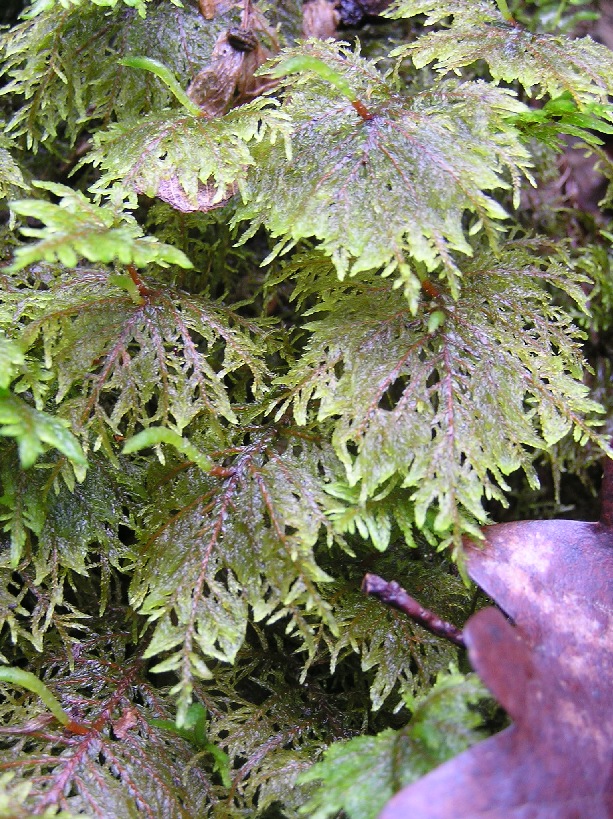- Hylocomium splendens
Taxobox
name = Glittering Wood-moss

regnum =Plant ae
divisio = Bryophyta
classis =Bryopsida
subclassis =Bryidae
ordo =Hypnales
familia =Hylocomiaceae
genus = "Hylocomium "
species = "H. splendens"
binomial = "Hylocomium splendens"
binomial_authority = "Hylocomium splendens", commonly known as Glittering Wood-moss, Stair-step Moss and Mountain Fern Moss, is a perennial clonalmoss [cite journal|last=Oekland|first=RH|date=1995|title= Population biology of the clonal moss Hylocomium splendens in Norwegian boreal spruce forests. I. Demography |journal= Journal of Ecology|volume=83|issue=4|pages=697-712|url=http://md1.csa.com/partners/viewrecord.php?requester=gs&collection=ENV&recid=3795430&q=Hylocomium+splendens&uid=792769599&setcookie=yes|accessdate=2008-05-18] with a widespread distribution inNorthern Hemisphere boreal forests. It is commonly found inEurope ,Russia ,Alaska andCanada , where it is often the most abundant moss species. It also grows in theArctic tundra and further south at higher elevations in, for example, northernCalifornia , westernSichuan ,East Africa ,Australia ,New Zealand and theWest Indies . In Scotland it is a characteristic species of theCaledonian Forest . Under theUK 's national vegetation classification system, pinewood community W18 is named as "Pinus sylvestris -Hylocomium splendens woodland", indicating its significance in this ecosystem. [http://www.treesforlife.org.uk/sp_glit_woodmoss.htm "Species Profile: Glittering wood-moss"] Trees for Life. Retrieved17 May 2008 .] [http://www.borealforest.org/lichens/lichen7.htm "Hylocomium splendens. Stair-step Moss"] borealforest.org. Retrieved17 May 2008 .] [http://www.rook.org/earl/bwca/nature/moss/hylocomium.html "Hylocomium splendens: Mountain Fern Moss"] Rook.Org. Retrieved16 May 2008 .] [ [http://www.biodiversityscotland.gov.uk/sbl_detail.php?id=39&type=2&navID=93&refpage=sbl_detail&tvk=NBNSYS0000014696 "The Scottish Biodiversity List - Species & Habitat Detail: W18"] BiodiversityScotland. Retrieved17 May 2008 .]It is generally olive green, yellowish or reddish green in colour, with reddish stems and branches. These often form branches up to 20 cm. long, with current year's growth starting from near the middle of the previous year's branch. This produces feathery fronds in steps. It is possible to estimate the age of a plant by counting the steps - a new level being produced each year. This form of growth enables the species to "climb" over other mosses and forest debris that falls on it. It is shade-loving, grows in soil and humus and on decaying wood and often forms mats with living parts growing on top of older, dead or dying sections. Further south, the plants are larger with several steps; further north, in the arctic
tundra , the plants are smaller with few steps. [cite web | url = http://efloras.org/florataxon.aspx?flora_id=50&taxon_id=200002578 | title = Hylocomium splendens (Hedwig) Schimper | work = Bryophyte Flora of North America ]The species has a commercial use in floral exhibitions and for lining fruit and vegetable storage boxes. In the past it was utilised as a floor covering for dirt floors and in Alaska and northern Canada it is still used for filling the gaps between the logs in log cabins. It has anti-bacterial qualities and may also contain anti-
tumour agents. [ Kimb, S. H. "et al" (2007) [http://www.sciencedirect.com/science?_ob=ArticleURL&_udi=B6VSC-4NG3T73-D&_user=10&_rdoc=1&_fmt=&_orig=search&_sort=d&view=c&_acct=C000050221&_version=1&_urlVersion=0&_userid=10&md5=d893e0379427f654caab685448a9f640 "Antibacterial activities of some mosses including Hylocomium splendens from South Western British Columbia"] Institute for Aboriginal Health/Sciencedirect.com. Retrieved17 May 2008 .]References
External links
[http://www.bioimages.org.uk/HTML/R159726.HTM "Hylocomium splendens" Images]
Wikimedia Foundation. 2010.
